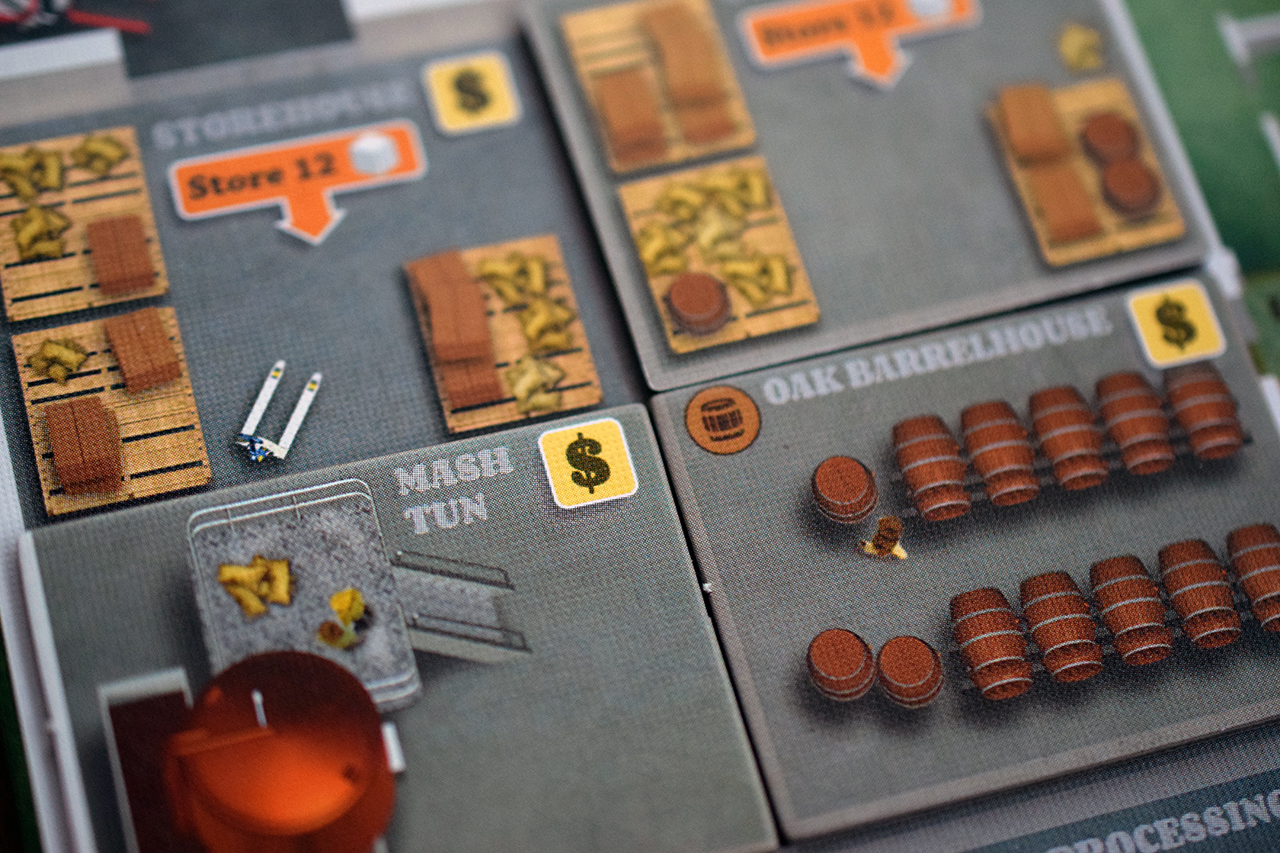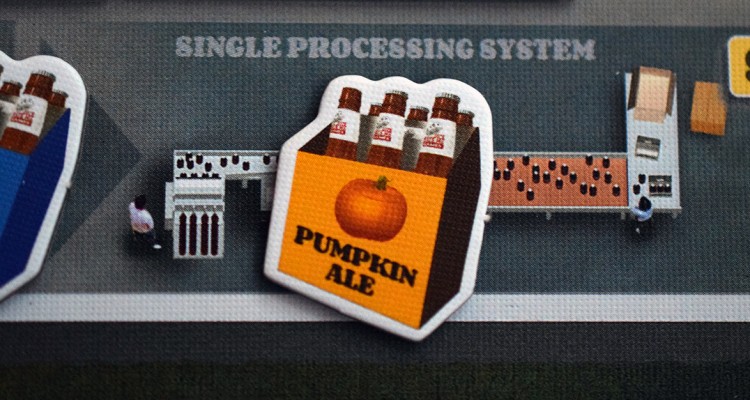Beer. The cause of, and the solution to, all of life’s problems. As the owner of a start-up brewing company, your job is to oversee the production, infrastructure decisions, purchasing and even the research efforts of your fledgling company. From the market, fresh hops, fine malt, and lively yeast are available to form the base of your creations, while sweet fruit, stimulating spices and rich coffee can be found to add a unique twist to what your brewery produces. Your challenge is to turn a profit in these competitive markets and prove the worth of your newfound brand.
Brew Crafters is a worker-placement game for two to five players by Ben Rosset, the designer of Mars Needs Mechanics and Between Two Cities. With a personal brewery board to place your upgrades on, and what I consider an ‘Agricola-style’ replenishing market, the basic mechanics of the title should be easily understood by anyone with a little bit of gaming familiarity.
One twist on the familiar, though, is that you’re given two different types of workers, split between the sections of the central board. You’ll have two (and only two!) Market meeples for use in gathering resources and hiring new workers, and begin the game with a single Brewery shift that will work to produce your beer, install new equipment in your brewery, and even conduct research in your own personal lab. Additional shifts may be hired after certain milestones have been reached, but you’d better be prepared to support their hefty salary!
Featuring both a static ‘beginners’ setup and a randomized selection for experienced players, the game provides plenty of replayability through the different combinations of beer recipes that are available for production and the skilled workers that can be hired. At the beginning of every game, six beers are chosen (two each from the selection of Porters, Stouts, and Ales), and added to the three basic recipes that are always available; these will be the beers that you can produce throughout the game. Each recipe requires varying amounts of Hops and Malt, and also one unit of Yeast. Advanced recipes may call for Fruit, Spices, or Coffee as well, with certain massive recipes needing more ingredients per batch than you can hold in your initial storehouse! In addition to the random recipes, twelve skilled worker cards are dealt out and placed beside the Market for hire. These cards may cost you an additional dollar during the Winter upkeep phase, but they are absolutely essential to your game, and snapping up one or two that combo well with your plan *will* mean the difference between victory and defeat.
Beechwood Aged
Since I mentioned ‘Winter’ above, I should note that the game is played over three years of four seasons each, with each season being the equivalent of a full game round. During a round, there are generally two phases, one for Market actions, and another for Brewery actions. Winter bookends these action phases with two additional moments for upkeep. Certain tiers of research allow you to take bonus actions or receive ingredients at the beginning of the Winter season, and this is when that happens. Additionally, at the end of Winter, you must be able to pay the upkeep cost of your brewery, or take negative reputation (VPs) in the form of loans. At the start of the game, your initial capital can last you through the first year if you’re thrifty, but it’s best to get brewing as early as you can!
At the start of each season, the Market is refilled and, beginning with the starting player, everyone will take one action at a time. These actions may include gathering Hops, Malt, or Yeast for storage back at the brewery, hiring workers (either a skilled worker card or an entire Brewery shift), throwing a fundraiser, forming a local partnership (more on this later!), or taking the starting player marker. Additionally, there are a number of more advanced action spaces that are available to be added to the board during setup if you desire a touch of additional complexity or more options. The only one of these that I’d consider essential is the space that allows you to hire Interns for the next two seasons. As these Interns can be used either in the Market or the Brewery, the extra actions can be essential before you have the means to hire a second shift.
Once the Market phase is over, players may then use their Brewery shifts to take actions on that section of the board. It’s important to note that while placement in the Market phase will block that space from anyone else during the round, anyone can perform the actions they want during the Brewery phase. Here is where you get to brew your beer, add upgraded equipment to your personal brewery, or conduct research to gain additional bonuses to certain aspects of the business.
Brewing beer is generally a three-step process and works like a pipeline; when this action is taken, you will sell any batch that has been bottled, bottle any batch that’s currently in the brew kettle, and then optionally add a fresh batch to the kettle by spending the ingredients listed on the recipe card from your storehouse. Selling beer is your main source of income in Brew Crafters, and it’s a flat $2 per batch, whether you’re pumping out pack after pack of Everyday Ale, or going for a limited run of Russian Imperial Stout. Where these recipes differ is the amount of reputation that they’re worth; at the end of the game, you’ll receive the VPs listed on the batch tokens that you have brewed, whether or not you’ve managed to sell it yet.
Along with the Skilled Workers from prior, upgrading the equipment in your brewery is how you’ll personalize your strategy in the game, and there are quite a few different items available. From the humble additional storehouse, needed for those high-value recipes, to an Oak Barrelhouse to age and flavor certain Stouts and Porters, on to the Hops Infusers for those that simply can’t get enough in their IPAs, there are plenty of options to tweak your brewery to your tastes.
Taking the Research action allows you to progress through the four tiers of bonuses available, ranging from a one-time bonus, to an annual Winter effect, a bonus to one particular action, and finally an end-game reputation bonus for meeting certain goals. There are four different categories of research, each generally affecting one aspect of your brewery. Additionally, these research boards are double-sided, with the initial side being equal around the table, while the advanced side includes different specialties if you’d like to mix things up a bit.
Once everyone has finished their Brewery actions, players recover their workers and the season marker advances to begin a fresh round. After the final Winter season of the third year, it’s time to pack things up and see just how you compared with the opposition! The player with the highest amount of reputation at this point is the winner!
Tasting Notes
Overall, this is a game that respects efficiency and focus in your actions; with little player interaction besides the availability of actions and Workers in the market, finding a niche and exploiting it ruthlessly tends to work much better than going for a generalist approach. I, too, prize efficiency when playing these sort of games, and with limited space to store ingredients before upgrading, there’s a good bit of satisfaction to be had when you finish out the round with an empty storehouse and a full bottling line! In terms of competition for actions, as most worker-placement games devolve into, I feel that Brew Crafters is a bit more forgiving in this manner. While you may not be able to get the exact resources you wanted from the market, you’re rarely left out from completing a needed /physical/ action, preventing the sort of bottleneck that keeps the game from moving forward for you. Additionally, when games have multiple paths and strategies available, I tend to try and explore them from play to play. The random spread of workers and recipes does call for attention to detail, as while one strategy may have been dominant in a previous game, you may just not have the parts available to make it work again in the next. I enjoy this, as the variability keeps the game from getting stale.
I promised I’d mention those partnership cards again, didn’t I? Well, there’s one each for Spices and Coffee, and what they do is allow you to, at any point in time, convert a basic ingredient (Hops, Malt, Yeast) to the appropriate advanced ingredient. With no action required, and no upkeep cost, as opposed to a Worker you may need to hire, these tend to be exceptionally powerful cards if your strategy utilizes either of these ingredients. For games of 4 players or more, there is a rather weaker version also available, and I’m mulling over the idea of tossing out the first and only leaving the latter one in play.
On a final note, while it’s rare that I’ll complain about a rulebook, it has to be mentioned that with all of the upgrades available for your brewery, you’d expect them to be explained in detail in the main rules, right? Unfortunately, the book merely refers to the separate player reference cards… which are about the size of a playing card and try to cram in the rules for all of these options in tiny text. Teaching new players about these upgrades and how they interact is probably the hardest part of learning the game, and these reference cards are simply not up to snuff.
Despite these last two quibbles, Brew Crafters is a game that I would recommend, especially to those with a penchant for analytical thinking and an enjoyment of building up a personal little empire as they see fit; even if that empire does consist of just a brewery.
[su_custom_gallery source=”media: 12499,12500,12498″ limit=”3″ link=”lightbox” width=”220″ height=”220″ title=”never”]
League Ruling
Matt
Brew Crafters is in many ways a game that we’ve seen before. With the familiar inner workings of other worker placement/resource collection/contract fulfillment games, it’s not unfair to stack this title up against well-known contenders like Agricola and Lords of Waterdeep. Where Brew Crafters makes its mark is in its well represented theme and wealth of variety. While the six components used to form each unique beer are the same across plays, and the general process of “brew, bottle, sell” is unavoidable, the sheer number of beer styles, special workers and brewery upgrades available makes each new go at alcoholic stardom feel fresh. This feeling is carried through by the wonderful attention to detail which represents all of the intricacies found in the brewing world. If you enjoy beer like I do, you’ll find yourself distracted with experimenting and indulging your inner brewmaster as you spend one game trying to be the table’s “Budweiser” and another game serving small-batch microbrews out of your in-house pub. The full spectrum of customization is here, from double-batch brewing systems, to oak-barrel aging houses and homegrown wheat fields.
It’s here that the design of Brew Crafters really shines for me, as I have the most fun picking a weird strategy and pursuing it regardless of its relative success. This is, unfortunately, also the downside I see of this title, as true success as the game defines it – via victory points – does not reward experimentation or exploration. Efficiency is key if you want to come out truly on top and, sadly, being the guy who spends all game growing his own coffee beans for a special run of imperial stouts doesn’t pay the bills. Time, money and resources are tight in Brew Crafters; you’ll quickly find that maximizing your actions with special workers, local partnerships and efficient research is always the way to success. While that still presents a fun and challenging puzzle, I would much rather tinker with the system than ride the conveyor belt it pushes you toward.
This is a wonderful break from the standard farming fair of games before and definitely my preferred theme for a resource gathering euro-style game. Unfortunately, I’ve found the general strategies toward optimal success to directly compete with all the fun and interesting options provided for the players.
Dan
Brew Crafters bottles a number of familiar euro game mechanics with a theme that appeals to the beer aficionado in me. While mechanically speaking this game doesn’t steer too far off the beaten path, the sheer variety and number of strategies to be explored gives each play a fresh feel. The different beer recipes along with the varied action spaces and specialized workers all combine to make for an enjoyable efficiency puzzle to solve (I have yet to figure out how the double bottling system is viable).
This game is tight; with only twelve turns in the game, it is nearly impossible to accomplish everything that you would like. The rigid economy also keeps you in check as you must plan accordingly in order to pay your workers and maintain your brewery. Failing to do so will result in wasting precious actions to collect money instead of valuable resources. My one gripe with the game is that set-up and tear down is a bear. Yes, there is a game tray that can be purchased, but rarely does a game warrant paying a price comparable to its MSRP for a third-party box insert.
Overall, Brew Crafters has earned a space on my shelf. Like a strong Belgian Quadruple, this game leaves you satisfied and slightly dizzied at the end. I’d gladly drink it any day.










